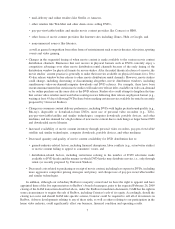Redbox 2008 Annual Report Download - page 10
Download and view the complete annual report
Please find page 10 of the 2008 Redbox annual report below. You can navigate through the pages in the report by either clicking on the pages listed below, or by using the keyword search tool below to find specific information within the annual report.Our DVD services business has a limited operating history and a history of operating losses.
Our DVD services business has a limited operating history and faces many of the risks inherent to a new
business. Redbox, the largest part of our DVD services business, had incurred a net operating loss each year since it
began operations in 2002 through 2007, and has only been profitable on a quarterly basis since the first quarter of
2008, although it may not be able to sustain profitable operations in the future. As a result of its limited operating
history, it is difficult to accurately forecast our potential revenue and operating results from DVD services. If we are
unable to attract customers to our DVD rental kiosks, our operations and financial condition will be adversely
affected. While we believe that the total addressable market for DVD rental kiosks is large, we cannot be certain
about its size or the most effective plan for locating kiosks. Because of our limited operating history and because the
DVD rental kiosk market and our business model for DVD services is rapidly evolving, we have very limited data
and track records for predicting kiosk and market performance in future periods. As a result, we may make errors in
predicting and reacting to relevant business trends which could have a material adverse effect on our business,
financial condition and results of operations. For example, we may, among other things, over-install kiosks in
certain geographic areas leading to non-accretive installations.
If we do not manage our DVD inventory effectively, our business, financial condition and results of opera-
tions could be materially and adversely affected.
A critical element of our DVD services business model is to optimize our inventory of DVD titles and copy
depth to achieve satisfactory availability rates to meet customer demand while also maintaining our desired
margins. If we do not timely acquire sufficient DVD titles and copy depth, due to, for example, not correctly
anticipating demand or by intentionally acquiring fewer copies than needed to fully satisfy demand, we may not
appropriately satisfy customer demand, which could decrease customer satisfaction and we could lose customers to
competitors. Conversely, if we attempt to mitigate this risk and acquire a larger number of copies to achieve higher
availability rates for select titles, our inventory utilization would become less efficient and our margins for DVD
services would be adversely affected. Our ability to accurately predict customer demand as well as market factors,
such as our ability to obtain satisfactory distribution arrangements, may impact our ability to timely acquire
appropriate quantities of certain DVD titles. In addition, if we are unable to obtain or maintain favorable terms from
our suppliers with respect to such matters as timely movie access, copy depth and product returns, among others, or
if the price of DVDs increases generally or for certain titles, our inventories may become unbalanced. Any of these
adverse developments could have a material adverse effect on our business, financial condition and results of
operations.
If our sell-back prices to distributors continue to decrease or we are restricted from selling DVDs at all, or
if there is an increase in customer demand for titles or formats that are more expensive for us to acquire,
our margins in the DVD services business could be adversely affected.
Margins in the DVD services business depend in part on our ability to negotiate favorable sell-back terms for
DVDs at the end of their rental life. The price at which we can sell back DVDs has declined in recent periods. If this
trend continues, or if we are otherwise restricted from selling our previously-viewed DVDs to our distributors or
customers, our operating results will be adversely affected. It is uncertain whether we will be able to negotiate
purchase and sell-back prices with our DVD distributors for new physical formats such as Blu-ray discs that will
allow us to be profitable under our current business model. Increased market acceptance of Blu-ray discs could also
put downward pressure on the distributors’ sell-back price for standard-definition DVDs, as demand for the old
format decreases. In addition, certain titles cost more for us to acquire, depending on the source from which they are
acquired and the terms on which they are acquired. If customer demand for these titles increases, our content
acquisition expenses could increase, and our margins could be adversely affected. Titles released on the new high-
definition formats, such as Blu-ray discs, may be more expensive to acquire than titles released on standard-
definition formats. The rate of customer acceptance and adoption of these new formats is uncertain. If customers
select the new higher-cost, high-definition formats on a proportional basis more often than standard-definition
formats, and if we are unable to negotiate attractive purchase and sell-back prices for both high- and standard-
definition formats with our distributors, our actual content acquisition expenses could increase and our margins in
the DVD services business could be adversely affected.
8























